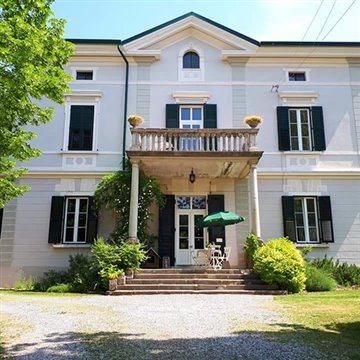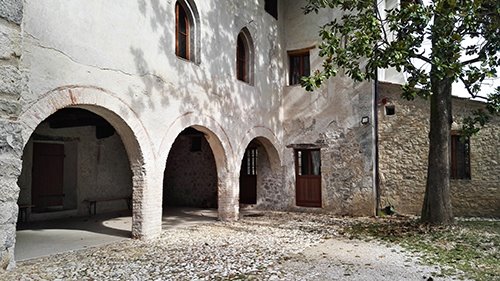 Sabrina Pellizon
Sabrina Pellizon
Ungewöhnliches Görz: Ein bukolischer Spaziergang zur Villa de Nordis



Nur wenige Kilometer von Majano entfernt befindet sich der kleine Vorort San Tommaso. Das Besondere an diesem kleinen Dorf ist seine Lage an der Via Alemagna, einer der Straßen, die die Pilger von Nordeuropa nach Venedig führte, wo sie sich dann einschifften, um das Heilige Land zu erreichen.

In San Tommaso steht das Pilgerspital Hospitale di San Giovanni di Gerusalemme, in dem Reisende Unterkunft und Essen finden konnten. Damals gab es in Abständen einer Tagesreise überall solche Orte. Heute hingegen ist es das einzige in Friaul Julisch Venetien erhaltene. Die Struktur ist zwar der Öffentlichkeit geöffnet, aber anlässlich des Fremdenführerwelttages hatte ich die Möglichkeit einer außerordentlichen geführten Besichtigung und erfuhr so mehr über seine unglaubliche Geschichte.
Es wurde um 1199 von den Johannitern errichtet und verwaltet. Anfänglich umfasste es nur den Turm, die Außenmauern und die Kirche San Giovanni und hatte die Funktion, Reisenden, Kreuzrittern und deren Pferden an einem vor eventuellen Angreifern geschützten Ort Unterkunft zu bieten. Der Komplex wurde 1200 durch den Bau des ersten Stockwerks der Loggia del Priore erweitert. 1348 wurde dann der Bau um eine weitere Etage aufgestockt.

Mit Ende der Kreuzzüge und der sich hieraus ergebenden Abnahme der Pilgerreisen wurde das Spital 1500 zu landwirtschaftlichen Zwecken umfunktioniert.
Nach seiner Zerstörung durch das Erdbeben von 1976 wurde es von der Gemeinde erworben und ist nun dabei, dank eines Verbands, der sich um seine Restaurierung bemüht, zu neuem Leben zu erwachen. Für den Wiederaufbau kamen beinahe ausschließlich vor Ort gefundene Originalbaustoffe zum Einsatz. Das gilt auch für die Dachbalken aus Holz. Das Ergebnis ist somit so originalgetreu wie nur irgend möglich. Beim Betrachten der Mauern sind Graffiti und Inschriften der Pilger, die im Spital übernachteten, und verschiedene Schichten zu sehen, die auf die verschiedenen Ausbauarbeiten zurückzuführen sind.
Auch die Kirche wurde restauriert. Der Führer erklärte uns die Bedeutung der Fresken, auch wenn ein Großteil davon durch das Erdbeben verloren gegangen ist. An der Südseite ist es heute noch möglich, einen Teil der Madonna der Barmherzigkeit von Nicolutto aus Gemona (1350) zu sehen, während es an der Nordseite Teile eines wahrscheinlichen Hl. Nikolaus, einer Madonna mit Kind und einer Szene zu sehen gibt, bei der es sich vermutlich um eine aus der Legende des Hl. Eligius von Noyon handelt. Der Holzaltar aus dem Jahr 1500 ist noch original von vor 1976. An der Außenwand sind die damals schon von Weitem von den Pilgern erkennbaren Heiligen Nicolas, Jakobus, Johannes und Christophorus gut zu sehen.
Derzeit ist das Hospitale ein multifunktioneller Komplex für diverse kulturelle und künstlerische Aktivitäten, aber schon bald wird es seine antike Funktion wieder aufnehmen. Der derzeitige Pächter der Struktur, der Verein Amici dell’Hospitale, veranstaltet im Abschnitt, der mit der via Allemagna zusammenfällt, Wanderungen am Tagliamento. Nicht zuletzt wegen des berühmten Jakobswegs und der an die via Allemagna anschließenden via Francigena ist eine Rückkehr zu einer gewissen Art des Slow-Tourismus zu verzeichnen, bei dem man das Gebiet entdecken und die Pilgerwege entlanggehen will. In den oberen Stockwerken des Hospitale werden schon bald Bettplätze für die neuen Pilger der via Allemagna verfügbar sein!
Entdecke die Angebote zu dieser Erfahrung in Friaul-Julisch Venetien
 Sabrina Pellizon
Sabrina Pellizon
